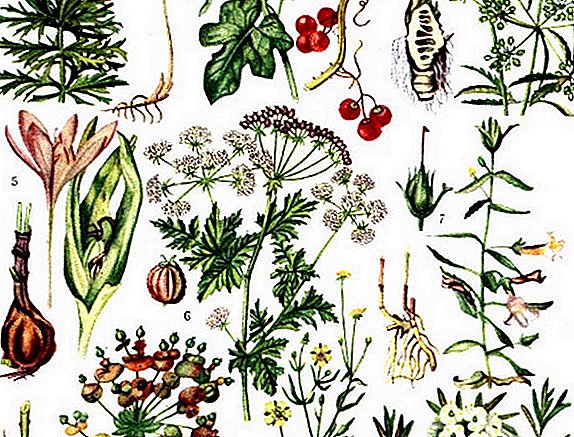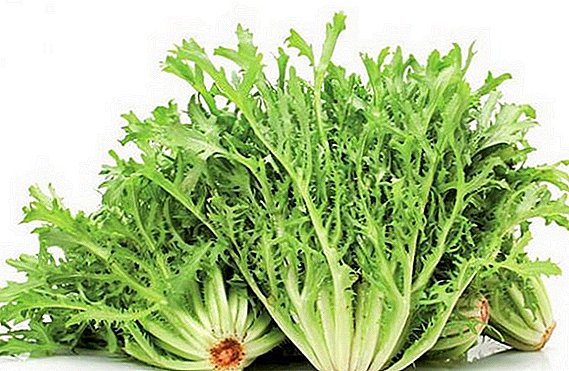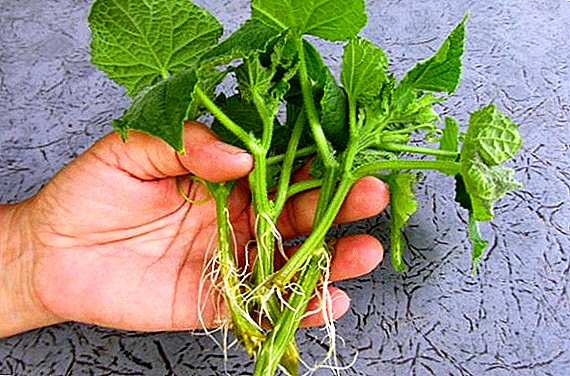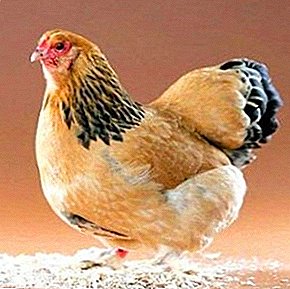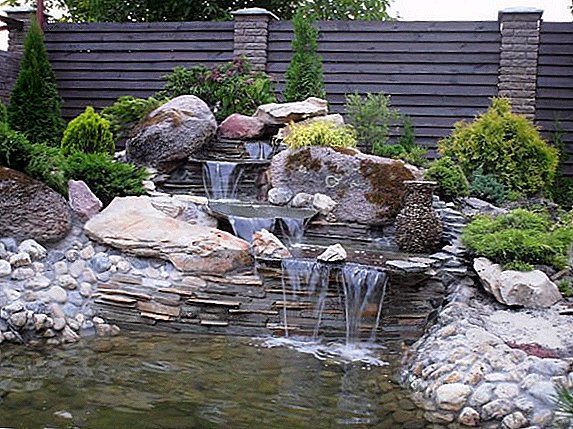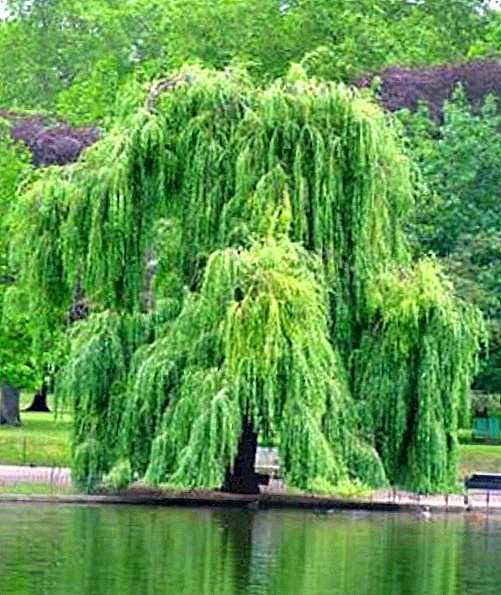 One of the most common representatives of the flora, almost all over the world is the willow Tristis.
One of the most common representatives of the flora, almost all over the world is the willow Tristis.
The people added to its title epithets white, silver, weeping. Due to its simplicity, willow quickly takes root and grows in almost any conditions. This fact has led to the fact that the tree is endowed with rich symbolism, tied to it many myths, legends and customs.
Willow is widely popular in medicine and landscape design.
The tree is also known under the names willow, belotal, molokitnik, rakita, tal, willow, white-headed goat, bredina, vetla. The variety of names often provokes questions of what it is. Consider the main features of the cultivation of white frost.
White willow
The white willow is high (20-30 m), an elegant deciduous tree representative of the Willow family. The lush crown of the plant resembles a giant tent. The trunk of the vetla can reach up to 3 m in diameter, it is covered with dark gray bark, with deep cracks.
The willow family also includes such types of willow: weeping, purple, goat, dwarf, spherical and whole-leaf.
Willow differs from other trees by wayward long flexible branches, olive-green or red-brown in color, which give it a volume and a special decoration. 
In the wild, there are about 600 species of willow, but in our climatic conditions live about 100.
Did you know? There is a myth among the people that willow has the power to develop 700 branches. In this regard, the tree is considered a symbol of a numerous genus. In addition, willow symbolizes beauty, a married woman, a beautiful grieving girl, sadness, memory. It is the verbal branches that sanctify in the church on Palm Sunday, endowing the willow with magical powers to protect a person from all bad things.
Silver willow blooms in late April or early May. Her yellow-green flowers are collected in inflorescences, similar to earrings. In the people willow inflorescences are called "cats". On one inflorescence, different-sex flowers bloom: the male ones have two stamens, the female ones have a pistil with the upper ovary.  Fruits, in the form of boxes with seeds, are formed on the faded "cats". The wind transports the ripened seeds to a huge state, which contributes to the wide spread of the tree. If the seeds fall into the water, they can remain viable for several years, in the open air they are capable of germination only for a while.
Fruits, in the form of boxes with seeds, are formed on the faded "cats". The wind transports the ripened seeds to a huge state, which contributes to the wide spread of the tree. If the seeds fall into the water, they can remain viable for several years, in the open air they are capable of germination only for a while.
The lifetime of the silver vetla is about 100 years. In one year, the tree can grow up to 100 cm in height and 50 cm in width.
Special attention should be paid to the description of willow leaves. They are lanceolate, narrow and long, the lower part of each leaf is covered with a small grayish fluff (hence the silver epithet). This feature gives the willow some femininity and tenderness. If the weather in the yard is windless, the leafy tree looks green, and when the breeze rises, the foliage starts to move, turn its lower side to the top, the tree becomes white.
Did you know? On the bottom of the leaves of silver willow often appear droplets of water. People say that these are willow tears. This fact has a scientific explanation. The fact is that the tree most often grows near water bodies, and its roots thirsty absorb moisture, which does not have time and can not evaporate in a natural way in a natural way, because the air near water bodies is already too humid. To get rid of the excess amount of moisture absorbed by the root system, the plant releases its droplets through the foliage.
Vetla has a strong and well-developed root system. It should be noted that the level of development and deepening of the roots depends on the level of groundwater occurrence: the closer the water, the less the roots develop. The roots of willows, growing in arid places, can go down by 2-3 m. 
Growing conditions
Despite the fact that white (weeping) willow is an unpretentious and undemanding tree, some measures must be observed during its planting. The better conditions to create this gentle beauty, the brighter and healthier she will look.
Location and lighting
Willow is a very light-loving and moisture-loving representative of flora. These factors should definitely be considered when choosing a place for planting.
It is best to select the wetland areas. Ideally - land near a pond, lake or other reservoir. Such a place is a guarantee that the tree will never suffer from a lack of moisture. 
Important! White willow withstand floods that do not cause it any pond. But the tree may die in a drought. The seat should be distinguished by good lighting. Best sunny areas or partial shade. In the shade willow does not grow.
Growing soil
To the type of soil willow generally unpretentious. The tree gives preference to light and medium loams. Willow grows quietly on sandy, swampy and not fertile gravelly soils.
Planting rules
Starting planting willow, it is worth considering the type of its root system. For planting willow, the root system of which is closed, is suitable any time - from April to October. Plants with an open root system are best planted in early spring, before bud breaks, or in late autumn, after the leaves have fallen.
The landing process itself consists of the following steps:
- Dig a pit for planting, the diameter of which for shrub species should be 50 cm, tall trees 60 cm. The depth of the planting pit for both species is 40 cm. A willow sapling with a closed root system is placed in a pit the size of which is equal to the earthly coma.
- If the soil is heavy, the bottom of the pit should be laid sand or rubble (20-30 cm) to provide drainage.
- For the direct planting of a willow sapling a substrate is prepared from peat, compost, soil in the same proportions, an azophosh is added to it (200 g for one plant). One third of the planting hole is filled with this substrate and a sapling is placed in it.
- After that, the pit is filled up, and the ground around it is tamped down, making a small depression for watering.
- After finishing the process, you need to pour two buckets of water on the soil.
- A tall seedling is tied up to a previously forgotten cola so that it does not break, and locked in an upright position.
Important! It is not necessary to plant heat-loving species of willow in the autumn, as they will not have time to get stronger by the beginning of the winter cold, and may die during the onset of frost.
How to care for a tree
Silver willow needs special care only during the adaptation to the new seat. Despite the fact that the plant is unpretentious, do not forget about it in the next years of life:
- The main rule of caring for a willow that was recently planted is watering, because the tree is extremely fond of moisture. It is necessary to water a sapling once a week early or in the evening. For the organization of the process using 2-5 buckets of water. Also, the tree needs spraying.
- Young white willows need to loosen the soil to the depth of the spade bayonet.
- In order for the tree to grow qualitatively, it is necessary to carry out soil mulching with peat, the layer of which should be 5-7 cm.
- For the formation of a decorative crown, vetlets make "haircuts" of long shoots and trimming dead branches.
- If you have noted a weak growth of the plant, it needs feeding. As a fertilizer, nitroammophoska (60-80 g / plant) is best suited.

Important! To create an aesthetic effect, the crown of vetla in the process of cutting can be formed in the form of a probe, a ball or even a rectangle.
Diseases and pests of white willow
Silver willow is an unpretentious tree, but this does not mean that it is necessary to neglect the rules of caring for it. In addition, the wind must be protected from diseases and pests, constantly monitor its health.
The most important pests that infect a willow are willowworm, flower fly and aphid.
Caterpillars moth gnaw leaves willows and deprive the tree of decorative appeal. The fight against such a pest is the destruction of clutches, larvae and insect moths by hand.
In early spring, willow is amenable to the attacks of a flower fly. To combat this pest, the tree is sprayed with Karbofos, Kinmiks or Decis.
To get rid of aphids, which sucks the vital juices from the plant, I use insecticides, in particular, “Fufanon”, “Karbofos”, “Aktellik”, “Akarin”.
The main diseases of white willow are powdery mildew, scab, rust, which lead to necrosis of leaf cells and young shoots. Eliminate such uninvited guests fungicides ("Fundazol", "Raek", "Topsin", "Topaz", "Fundazim").
Spheres of application
Willow is distinguished not only by the diversity of species, but also by the richness of its uses.
Ever since ancient times, its branches have been widely used in basket weaving, verbal fishing was very popular, which can be traced in our time. Such popularity is due to the excessive flexibility of the verbal branches. From the willow weave baskets, chairs, fences and other items. Fiber for bark is made fiber for laces, ropes, burlap.  The palm bark is a well-known drug. Tinctures from crushed bark are used to treat colds, fevers, and compresses from such tinctures reduce fever. In addition, a decoction is made from the verbal bark, which effectively cleans and heals wounds, burns, sores and other injuries.
The palm bark is a well-known drug. Tinctures from crushed bark are used to treat colds, fevers, and compresses from such tinctures reduce fever. In addition, a decoction is made from the verbal bark, which effectively cleans and heals wounds, burns, sores and other injuries. 
Did you know? Salicylic acid, the name of which comes from the Latin word salix, meaning willow, was extracted from the verbal bark in the 20th century.
One of the main purposes of willow is to help designers create superb landscape designs. Willow is an indispensable element in the landscaping of city parks, the decoration of summer cottages and gardens. An unrivaled decorative ornament is a willow hedge.  At first glance, willow is an inconspicuous plant. We got used to the fact that the tree grows at almost every step and often do not pay attention to its feminine attractiveness and value. But, despite this attitude, willow gives a person not only aesthetic pleasure, but comfort (if it is a material for making furniture) and health, it is a question of the medicinal properties of the vetla.
At first glance, willow is an inconspicuous plant. We got used to the fact that the tree grows at almost every step and often do not pay attention to its feminine attractiveness and value. But, despite this attitude, willow gives a person not only aesthetic pleasure, but comfort (if it is a material for making furniture) and health, it is a question of the medicinal properties of the vetla.
Given the fact that planting and caring for a tree does not require a lot of work and time, such a plant rightfully occupies the title of the leading decorative ornament of garden and park areas.




